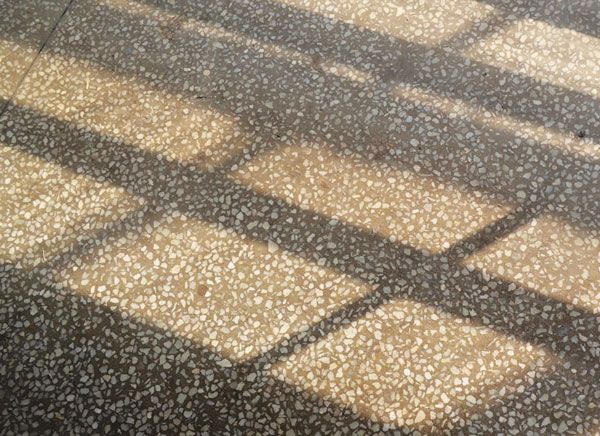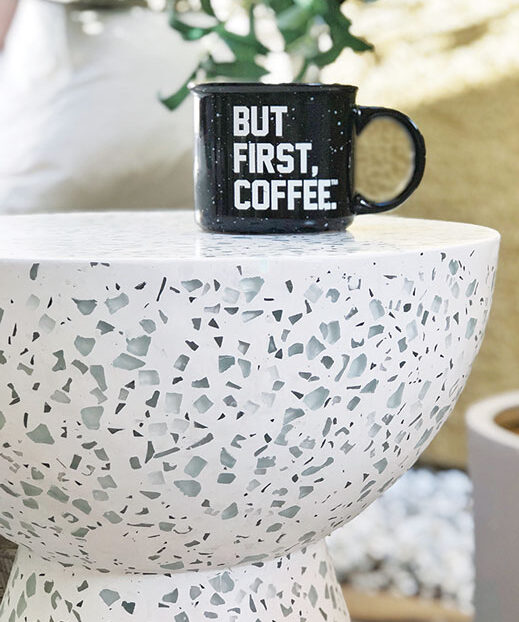Tempting Terrazzo
Writer Ren MillerTurning thrift into works of art.

Terrazzo can be monochromatic — as in this example with chips and base in a narrow color range — or much more varied, depending on the aggregate material — or chips — that give the flooring its characteristic appearance. | Courtesy of PublicDomainPictures.net
When the dust settled after a long day of cutting stones for construction projects, the small scraps that remained might have ended up in a trash heap. It was the 15th century, however, and the workers erecting the famed marble buildings and bridges of Venice were not wasteful. Instead, they took the scraps home to use in a then-humble, now-valued technique for creating solid surfaces.
They placed the scraps in clay and smoothed them with heavy rubbing stones to create durable floors, walkways, even terraces, or terrazzo in Italian. And that’s how terrazzo — the practice of embedding pieces of stone or other material in a binder — got its name. The concept dates back to ancient Egyptian mosaics. With terrazzo, however, the stones were thrown into a base of clay — later cement — to create a random pattern rather than a planned design, as was the case with mosaics.

The terrazzo technique is used today in many home furnishing categories in addition to flooring, including tile, countertops and even specialty furniture as shown here. Also, patterns that imitate terrazzo are found in everything from wallpaper to rugs to fabrics. | Photo by Rebecca Orlov/Epic Playdate, Unsplash
The workers eventually attached handles to the rubbing stones so they could stand and use their body weight to create more force, achieving a smoother surface, says the TREND Group, an expert on terrazzo and leading producer of colored glass mosaic, Venetian enamel and engineered stone surfaces. But one challenge remained: the surface was dull — until someone spilled the milk. Goat’s milk, that is. No one seems to know how — whether on purpose or an accidental spill — but the workers came to realize that coating the terrazzo with goat’s milk restored the marble’s original luster.
Terrazzo quickly captured the attention of artists and artisans. In the mid-1500s, Michelangelo designed terrazzo floors for St. Peter’s Basilica. By the mid-1700s, terrazzo had found its way to North America when George Washington used it while enlarging Mount Vernon. A century later, as Europeans flocked to the United States to escape food and job shortages, Italian immigrants known as terrazeri found work plentiful in Gilded Age mansions.
Two developments in the 1920s fed an explosion in the popularity of terrazzo, the TREND Group says. The first was the invention of electric grinders that allowed for “finer finishes, greater speeds and lower costs.” The second was the introduction of metal strips to divide the flooring into sections, which not only solved the problem of cracks developing in large expanses but also allowed for patterns by using different color mixes in adjacent sections of terrazzo. The dividers could even be bent for intricate designs (the Hollywood Walk of Fame with its colored stars is terrazzo). “Architects soon began jumping on the terrazzo bandwagon as they realized it was the ideal medium for their smooth, curvilinear Art Deco designs,” the TREND Group adds. Even Richard Neutra and other modernist architects chose terrazzo flooring for some of their 1950s designs.
By that time Portland cement was the most common base material for terrazzo. It was stable and could be dyed any color. Called cementitious terrazzo, it consists of a thick concrete layer, a thinner layer of sandy concrete into which the dividers are embedded, and then a final layer consisting of chips of marble, granite, glass, seashells or other material before the surface is ground down, sealed and polished.
Epoxy-resin based terrazzo revolutionized terrazzo in the 1970s. Called thin-set terrazzo, it has several advantages over cement-based terrazzo: It can be poured into place along with the stone or other aggregates, can be any color, is thinner and lighter weight, allows faster installation, has an impermeable finish and is less susceptible to cracking. The main disadvantage: It should be used only indoors to keep its color and avoid peeling.
For more information on terrazzo, visit the website of The National Terrazzo and Mosaic Association Inc., an organization that establishes national standards for terrazzo floor and wall systems.
